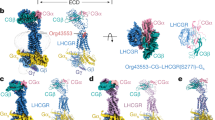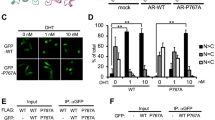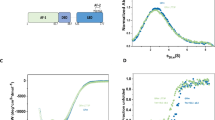Abstract
The mechanism of action of antisteroids is not understood and explanations of their antagonistic activity have been sought at all levels of hormone action. It has been proposed that antisteroids, after binding to receptor, trap it into a non-activated (non DNA-binding) form possibly through interaction with a heat-shock protein of relative molecular mass (Mr) 90,000 (90 K)1, or that the antisteroids provoke binding of receptor to nonspecific DNA sites but not to hormone responsive elements (HREs)2, or that the antisteroid-receptor complexes can bind to HREs but form abortive complexes that fail to regulate transcription3,4. We have constructed a deleted cDNA encoding a mutant form of rabbit progesterone receptor which exhibits constitutive activity, that is, binds to HREs in the absence of hormone and thus bypasses the first two steps discussed above. Co-transfection experiments allowed the expression of both constitutive and wild-type receptors in the same recipient cells. Antiprogestin RU486–wild-type receptor complexes completely suppressed the activity of the constitutive receptor on a reporter gene, showing that the inhibition is at the level of their common responsive elements.
This is a preview of subscription content, access via your institution
Access options
Subscribe to this journal
Receive 51 print issues and online access
$199.00 per year
only $3.90 per issue
Buy this article
- Purchase on Springer Link
- Instant access to full article PDF
Prices may be subject to local taxes which are calculated during checkout
Similar content being viewed by others
References
Groyer, A., Schweizer-Groyer, G., Cadepond, F., Mariller, M. & Baulieu, E. E. Nature 328, 624–626 (1987).
Sutherland, R. L. & Murphy, L. C. Molec. cell. Endocr. 25, 5–23 (1982).
Richard-Foy, H., Sistare, F. D., Tate Riegel, A., Simons, S. S., Jr. & Hager, G. L. Molec. Endocr. 1, 659–665 (1987).
Rajpert, E. J. et al. J. Steroid Biochem. 26, 513–520 (1987).
Gluzman, Y. Cell 23, 175–182 (1981).
Cato, A. C. B., Miksicek, R., Schütz, G., Arnemann, J. & Beato, M. EMBO J. 5, 2237–2240 (1986).
Brailly, S. et al. J. Endocr. 116, 427–434 (1988).
Moguilewsky, M. & Philibert, D. in The Antiprogestin Steroid RU486 and Human Fertility Control (eds Baulieu E. E. & Segal S. J. ) 87–98 (Plenum New York, 1985).
Beato, M. Biochim. Biophys. Acta 910, 95–102 (1987).
Cato, A. C. B., Skroch, P., Weinmann, J., Butkeraitis, P. & Ponta, H. EMBO J. 7, 1403–1410 (1988).
Mullick, A. & Katzenellenbogen, B. S. Biochem. biophys. Res. Commun. 135, 90–97 (1986).
Rauch, M., Loosfelt, H., Philibert, D. & Milgrom, E. Eur. J. Biochem. 148, 213–218 (1985).
Bailly, A., Le Page, C., Rauch, M. & Milgrom, E. EMBO J. 5, 3235–3241 (1986).
Green, S. & Chambon, P. Nature 324, 615–617 (1986).
Moguilewsky, M. & Philibert, D. J. Steroid Biochem. 20, 271–276 (1984).
Bourgeois, S., Pfahl, M. & Baulieu, E. E. EMBO J. 3, 751–755 (1984).
Becker, P. B., Gloss, B., Schmid, W., Strähle, U. & Schütz, G. Nature 324, 686–688 (1986).
Rochefort, H. & Borgna, J-L. Nature 292, 257–259 (1981).
Loosfelt, H. et al. Proc. natn. Acad. Sci. U.S.A. 83, 9045–9049 (1986).
Graham, F. L. & van der Eb, A. J. Virology 52, 456–467 (1973).
Gorman, C. M., Moffat, L. F. & Howard, B. H. Molec. cell. Biol. 2, 1044–1051 (1982).
Logeat, F., Le Cunff, M., Pamphile, R. & Milgrom, E. Biochem. biophys. Res. Commun. 131, 421–427 (1985).
Loosfelt, H., Logeat, F., Vu Hai, M. T. & Milgrom, E. J. biol. Chem. 259, 14196–14202 (1984).
Logeat, F. et al. Proc. natn. Acad. Sci. U.S.A. 80, 6456–6459 (1983).
Herbomel, P., Bourachot, B. & Yaniv, M. Cell 39, 653–662 (1984).
Maxam, A. M. & Gilbert, W. C. Meth. Enzym. 65, 499–560 (1980).
Lopeat, F. et al. Biochemistry 24, 1029–1035 (1985).
Author information
Authors and Affiliations
Rights and permissions
About this article
Cite this article
Guiochon-Mantel, A., Loosfelt, H., Ragot, T. et al. Receptors bound to antiprogestin form abortive complexes with hormone responsive elements. Nature 336, 695–698 (1988). https://doi.org/10.1038/336695a0
Received:
Accepted:
Issue Date:
DOI: https://doi.org/10.1038/336695a0
This article is cited by
-
Steroid hormones modulate H19 gene expression in both mammary gland and uterus
Oncogene (1999)
-
Promoter- and cell-specific responses to sex steroids
Osteoporosis International (1997)
-
Interaction of newly synthesized antiprogesterone ZK98299 with progesterone receptor from human myometrium
Molecular and Cellular Biochemistry (1994)
-
The differential effects of stanozolol on human skin and synovial fibroblastsin vitro: DNA synthesis and receptor binding
Agents and Actions (1994)
Comments
By submitting a comment you agree to abide by our Terms and Community Guidelines. If you find something abusive or that does not comply with our terms or guidelines please flag it as inappropriate.



